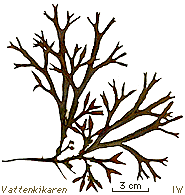 |
|
When
all the eggs and sperm have been emitted, the recepticle yellows and dies,
thereafter the branch upon which it sat also dies. Those plants that had
many fertile shoots can be substantially "defoliated" when its reproductive
period ends.
Bladder wrack without bladders |
Bladder wrack that grows in areas that are
exposed to powerful
wave action can lack bladders. The plants have a tendency to be
shorter, more slender and less branched. They resemble arctic wrack
(Fucus evanescens = Fucus distichus = Fucus inflatus),
which does not have a middle nerve on the uppermost branches and has
a noticably long hermaphroditic recepticle.
In the Baltic there is a form of bladder wrack that
has a narrow lobe and a bushier appearance. Bladder wrack with this
appearance is seldom longer than 1 dm, and they lie loose on the bottom
and drift about in small piles.
Bo Johannesson |

|
 |
Page 4 of 4 | |
|


